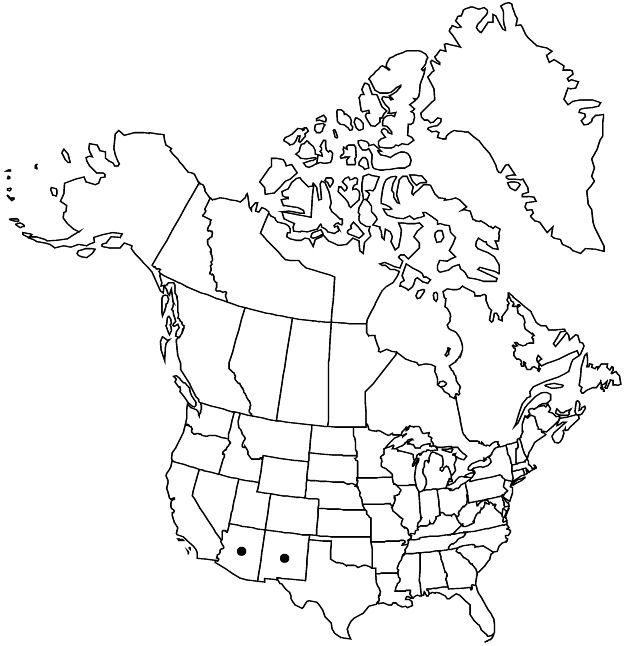Difference between revisions of "Philadelphus microphyllus var. madrensis"
J. Bot. Res. Inst. Texas 1: 901. 2007.
FNA>Volume Importer |
FNA>Volume Importer |
||
| Line 8: | Line 8: | ||
}} | }} | ||
|common_names=Montane mock orange | |common_names=Montane mock orange | ||
| − | |basionyms={{Treatment/ID/ | + | |basionyms={{Treatment/ID/Basionym |
|name=Philadelphus madrensis | |name=Philadelphus madrensis | ||
|authority=Hemsley | |authority=Hemsley | ||
| + | |publication_title=Bull. Misc. Inform. Kew | ||
| + | |publication_place=1908: 251. 1908 | ||
}} | }} | ||
|synonyms= | |synonyms= | ||
| Line 27: | Line 29: | ||
|elevation=1800–2700 m. | |elevation=1800–2700 m. | ||
|distribution=Ariz.;N.Mex.;Mexico (Chihuahua;Durango;Sonora). | |distribution=Ariz.;N.Mex.;Mexico (Chihuahua;Durango;Sonora). | ||
| − | |discussion=<p>Variety madrensis is primarily Mexican, centered in the Sierra Madre Occidental of Chihuahua, Durango, and Sonora, entering the United States in southeastern Arizona (Chiricahua Mountains, Cochise County; Pinaleño Mountains, Graham County; Catalina Mountains, Pima County); and southwestern New Mexico (Burro Mountains). In populations within the floral area, over 90% have erect, sometimes chaotically oriented, hairs on the adaxial leaf surface, and in the Chiricahua Mountains, nearly half have erect hairs on the abaxial leaf surface, and some have chaotic hairs throughout leaves, hypanthia, and young stems. Some plants have a dense vestiture of loosely appressed elongate hairs (to 1.5 mm) on the abaxial leaf surface as in the type from Durango, Mexico. Plants in the higher mountains have relatively large, often weakly serrulate leaves, and typically flowers are in threes at stem tips (but only solitary in the Pinaleño Mountains). Some plants around Rucker Canyon and Fly Peak in the Chiricahua Mountains are vegetatively similar but have sericeous vestiture and may be considered introgressants with <i></i>var.<i> microphyllus</i>. The characteristics of <i></i>var.<i> madrensis</i> and the southern phase of <i></i>var.<i> microphyllus</i> are mixed in plants found in the Rincon and Santa Rita Mountains in southeastern Arizona.</p> | + | |discussion=<p>Variety madrensis is primarily Mexican, centered in the Sierra Madre Occidental of Chihuahua, Durango, and Sonora, entering the United States in southeastern Arizona (Chiricahua Mountains, Cochise County; Pinaleño Mountains, Graham County; Catalina Mountains, Pima County); and southwestern New Mexico (Burro Mountains). In populations within the floral area, over 90% have erect, sometimes chaotically oriented, hairs on the adaxial leaf surface, and in the Chiricahua Mountains, nearly half have erect hairs on the abaxial leaf surface, and some have chaotic hairs throughout leaves, hypanthia, and young stems. Some plants have a dense vestiture of loosely appressed elongate hairs (to 1.5 mm) on the abaxial leaf surface as in the type from Durango, Mexico. Plants in the higher mountains have relatively large, often weakly serrulate leaves, and typically flowers are in threes at stem tips (but only solitary in the Pinaleño Mountains). Some plants around Rucker Canyon and Fly Peak in the Chiricahua Mountains are vegetatively similar but have sericeous vestiture and may be considered introgressants with <i></i></i>var.<i><i> microphyllus</i>. The characteristics of <i></i></i>var.<i><i> madrensis</i> and the southern phase of <i></i></i>var.<i><i> microphyllus</i> are mixed in plants found in the Rincon and Santa Rita Mountains in southeastern Arizona.</p> |
|tables= | |tables= | ||
|references= | |references= | ||
| Line 51: | Line 53: | ||
|publication year=2007 | |publication year=2007 | ||
|special status= | |special status= | ||
| − | |source xml=https://jpend@bitbucket.org/aafc-mbb/fna-data-curation.git/src/ | + | |source xml=https://jpend@bitbucket.org/aafc-mbb/fna-data-curation.git/src/f6b125a955440c0872999024f038d74684f65921/coarse_grained_fna_xml/V12/V12_1007.xml |
|genus=Philadelphus | |genus=Philadelphus | ||
|species=Philadelphus microphyllus | |species=Philadelphus microphyllus | ||
Revision as of 18:14, 24 September 2019
Leaf blades (0.7–)1.6–3(–5.5) × (0.4–)0.7–1.3(–3.3) cm, herbaceous to coriaceous, margins usually entire, on larger leaves sometimes sparsely serrulate, abaxial surface whitish gray, sparsely to moderately sericeous, hairs appressed, loosely appressed, ascending, or chaotic, ± coarse, straight or wavy-curved hairs, 0.5–1.5 mm, infrequently more densely lanate with understory of more slender, wavy-curved, adaxial surface green, drying gray-green or brown (cuticle thick, smooth or mottled smooth and papillate), sparsely to moderately strigose-sericeous, hairs both appressed or loosely appressed, thick, 0.2–1 mm, and erect, 0.2–0.7 mm, or all erect. Inflorescences 1–3(–5)-flowered. Flowers 25–37 mm diam.; hypanthium and sepal abaxial surfaces moderately, often loosely, sericeous, hairs wavy, weakly appressed or erect to spreading, 0.4–1.2 mm, not obscuring epidermis; sepals (3.5–)5–8.5(–10) mm; petals 9–12(–16) × 6–11 mm; stamens 32–46+. Capsules globose-turbinate, 5–8 × 3.8–6.5 mm.
Phenology: Flowering Jun–Aug; fruiting Jul–Nov.
Habitat: Oak, pine, and fir forests, open, rocky rhyolitic ridges.
Elevation: 1800–2700 m.
Distribution

Ariz., N.Mex., Mexico (Chihuahua, Durango, Sonora).
Discussion
Variety madrensis is primarily Mexican, centered in the Sierra Madre Occidental of Chihuahua, Durango, and Sonora, entering the United States in southeastern Arizona (Chiricahua Mountains, Cochise County; Pinaleño Mountains, Graham County; Catalina Mountains, Pima County); and southwestern New Mexico (Burro Mountains). In populations within the floral area, over 90% have erect, sometimes chaotically oriented, hairs on the adaxial leaf surface, and in the Chiricahua Mountains, nearly half have erect hairs on the abaxial leaf surface, and some have chaotic hairs throughout leaves, hypanthia, and young stems. Some plants have a dense vestiture of loosely appressed elongate hairs (to 1.5 mm) on the abaxial leaf surface as in the type from Durango, Mexico. Plants in the higher mountains have relatively large, often weakly serrulate leaves, and typically flowers are in threes at stem tips (but only solitary in the Pinaleño Mountains). Some plants around Rucker Canyon and Fly Peak in the Chiricahua Mountains are vegetatively similar but have sericeous vestiture and may be considered introgressants with var. microphyllus. The characteristics of var. madrensis and the southern phase of var. microphyllus are mixed in plants found in the Rincon and Santa Rita Mountains in southeastern Arizona.
Selected References
None.